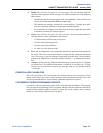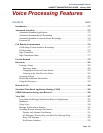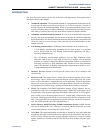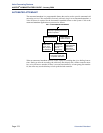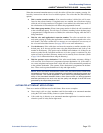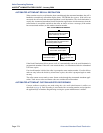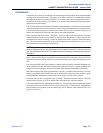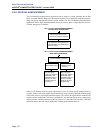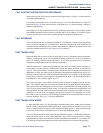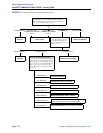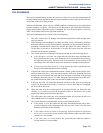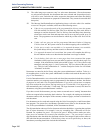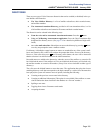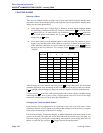
Page 275
Voice Processing Features
AXXESS
®
ADMINISTRATOR’S GUIDE – January 2004
Extension ID
EXTENSION ID
Extension IDs are used in conjunction with transferring calls through the Automated Attendant
or using the Extension Directory. The extension ID allows callers to be transferred to stations
and applications that do not have mailboxes. It also allows the station or application to have a
recorded name in the directory. This feature is set up and initialized using Database Program-
ming and voice mail features.
If an Extension ID has been created in Database Programming for a station extension number,
either the principal owner of the extension or the voice mail administrator must set up (initial-
ize) the ID with a new password and record a name for use in the Extension Directory. At
default, the extension ID password is the same as the extension number.
If the Extension ID has not been “initialized,” calls can still be transferred to the associated
extension number. However, they cannot be accessed from the directory. If the Extension ID’s
username has not been recorded, it cannot be heard when callers access the Extension Direc-
tory. The name must be recorded in order to fully initialize the Extension ID. See page 295 for
more information on initializing Extension IDs.
NOTE: To provide system security, all extension IDs should have a password. To make the
passwords difficult to guess, they should not match the station’s extension number or consist of
one digit repeated several times. The default password should be changed the first time the
user logs in.
Once a password has been set up and the name recorded, the extension owner may access
Extension ID Options which allows the associated directory name and password to be modi-
fied.
If an Extension ID has not been created for a station, callers using the automated attendant can-
not be transferred to that destination. Instead, these callers will receive a system recording noti-
fying them of an invalid entry and are routed back to the automated attendant’s main menu.
Individual extension IDs can be programmed as “Private” in Database Programming. A Private
number is included in the directory and can be dialed if the caller knows the number, but the
extension number information is not available to the caller; only the name is played.
Extension IDs can also be programmed as “Unlisted.” That means that the number will not be
included in the directory, but can be dialed if the caller knows the extension number.
Calls transferred from the Automated Attendant or a Call Routing Announcement application
to stations with extension IDs can be screened, announced, or unannounced. Programming
flags determine the methods used for transferring calls to stations with extensions IDs. (See
page 206 for details.)



